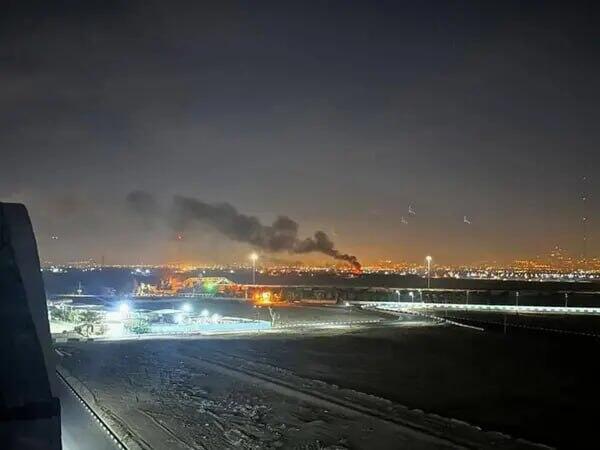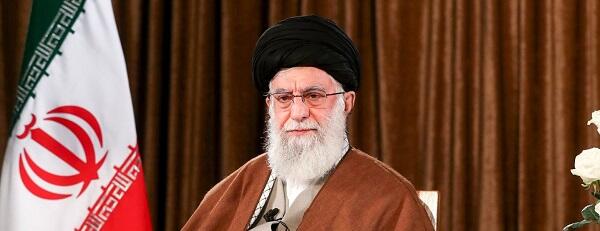Getting your Trinity Audio player ready...
The Iranian leadership, spearheaded by Supreme Leader Ali Khamenei, is currently grappling with a complex dilemma over whether and how to respond to last night’s Israeli airstrikes.
This challenge arises from the need to balance three critical considerations: Firstly, the regime's prestige and its capability to defend Iran's territory have undoubtedly been compromised in the eyes of a significant segment of its population.
Israeli attacks as they unfolded
Secondly, there are commitments from the Revolutionary Guards and Iranian political figures, such as President Masoud Pezeshkian and Foreign Minister Abbas Araghchi, to respond forcefully to any Israeli aggression.
The third consideration is purely militaristic. Israel has apparently inflicted severe damage on Iran's air defense systems, which were supposed to protect the Islamic Republic’s most sensitive military centers from aerial and missile attacks. These systems were intended to safeguard Tehran, the capital, and its surrounding military facilities and factories.
As of early Saturday morning, there is no precise assessment of the damage inflicted on Iran's air defenses, but it is reasonable to assume that they were significantly impaired in the initial wave of attacks, given that the Iranians barely intercepted any missiles or Israeli fighter jets.
With Iran's air defenses neutralized in several critical areas, Iranian leaders will have to carefully consider whether to launch a strong attack on Israel and risk a counter-response they cannot stop. It is difficult at this moment to predict the thoughts of Khamenei and the Revolutionary Guards' leaders, but they will likely reconsider continuing this tit-for-tat exchange with Israel.
Meanwhile, Israel and the United States, operating in coordination, have explicitly informed Tehran that, from Washington's and Jerusalem's perspectives, it is possible to "close the account now." Last night's strike was deliberately designed to offer the Iranian regime the option to avoid retaliation. IDF spokesperson explicitly stated the strike was "focused," and Israel has no interest in prolonging the exchange of blows. White House spokesperson conveyed similar messages to reporters in a briefing, and this clear signal to Tehran may influence its decision-making process.
For Israeli citizens, this primarily means staying attentive to announcements from IDF spokesperson and the Home Front Command. Daily life can continue as usual, albeit with increased vigilance. Even if Iran decides to launch a surprise attack in the coming hours, as they have threatened, Israeli citizens will still have at least 12 minutes to receive a warning and take cover—even if the Home Front Command has not issued general restrictions hours in advance.
Significant impacts
Last night's attack on Iran represents a strategic and military masterpiece. The strikes on targets in three provinces aimed to achieve several objectives simultaneously: a tangible impact on Iranian military capabilities, a clear signal to the regime that it is exposed and vulnerable, which strengthens deterrence, and a severe blow to its prestige in the eyes of its citizens—all while carefully giving Tehran a "ladder to climb down from the tree," providing a justification to halt the cycle of retaliation. This strategy primarily serves to avoid igniting a regional war that neither Israel, the U.S., nor Iran currently desires.
The strike in Iran—approximately 1,000 miles between Tehran and Tel Aviv
Breaking down these objectives into concrete goals, the Israeli attack aimed to achieve the following: significant damage using various munitions—according to Iranian reports, "long-range suicide drones and long-range ballistic missiles launched from aircraft"—on Iran's air defense systems, including radars and missile interception batteries. This damage was intended to enable subsequent waves of attacks to be executed with the Israeli Air Force having the freedom to launch missiles and even fly toward Iranian territory.
The second goal was to damage facilities for the development and production of surface-to-surface missiles and rocket engines, likely carried out in several locations around Tehran—primarily in the industrial city of Karaj, where UAV and missile and rocket engine development and production plants are located. These factories have been targeted in the past, a few years ago, by sabotage actions attributed to Mossad, which in one instance resulted in the death of an Iranian general.
This time, the strikes in Iran were carried out around 2:00 AM, when no civilians were present in these factories—a deliberate move to avoid civilian casualties, which would compel the regime to retaliate against Israel. This is part of the precise calibration of the attacks, with maximum effort, as mentioned, to give Iran the option to "climb down from the tree" and not retaliate against Israel.
Another set of targets in the Ilam and Khuzestan provinces includes surface-to-surface missile launch facilities and arrays, from which ballistic missiles were launched at Israel in the two previous Iranian attacks. While the damage to these arrays does not prevent Iran from launching ballistic missiles at Israel from these mountainous regions in the Zagros Mountains, it serves as a signal to Tehran that if another round occurs, these arrays could suffer much more severe damage in the absence of air defense over them—as IDF spokesperson explicitly stated: "Anyone who tries to drag us into escalation will pay a heavy price."
Reports from Syrian opposition sources, as well as Iraqi and Iranian media, almost conclusively indicate that the flight path of the Israeli Air Force jets did not pass over the territory of any Sunni Arab states allied with the U.S.
Strategic strikes in Syria and Iraq: Translating threats into action
Before the facilities in Iran were targeted, Syrian opposition reported that a major radar station in the As-Suwayda region in southern Syria, near the Jordanian border, was struck. This area is known for its sparse air defenses, and its northern part, beyond the Euphrates River, is controlled by Free Syrian forces and Kurds collaborating with U.S. forces. Reports also emerged of strikes in Iraq, similarly targeting air defense systems.
The flight path of the Israeli fighter jets reportedly mirrored that of a previous strike attributed to Israel, which focused on an S-300 missile and aircraft defense battery in the Isfahan region. That battery was successfully hit. Leaked Pentagon documents had suggested that Israel might employ ballistic missiles launched from aircraft, allowing them to be far from the actual target.
In the previous Israeli strike on Iran, the focus was on a single location—Isfahan, where missiles and UAVs are developed, and near which lies the Natanz uranium enrichment facility. The message to the Iranians at that time was clear: "We can neutralize your air defenses, and when we do, we have the freedom to strike nuclear and missile facilities in the area, even if they are underground."
This time, the message has been translated from a mere threat to concrete action. After neutralizing air defense systems in several locations in central and southwestern Iran, Israeli Air Force jets launched munitions at actual targets, significantly impairing Tehran’s missile production capabilities. This forces the Iranian regime to consider whether it is worthwhile to "expend" missiles in another retaliatory strike against Israel, especially as it will struggle to replenish its stockpile of missiles and UAVs.
The strikes around Tehran were deliberately executed, likely using munitions that caused fires visible from a distance, witnessed by citizens. The same occurred in several other large cities in the targeted provinces. This was part of Israel's strategy to weaken the Ayatollah regime’s standing, which is already unpopular, by heightening the threat of civil uprisings. Historically, such uprisings have toppled governments in Iran, including the Shah's regime.
A Message to Iranian opposition: The regime is weak
Certain provinces in Iran are inhabited by ethnic minorities in conflict with the regime, including the Baloch along the Iran-Afghanistan border, Arabs in the Khuzestan region, and Kurds in the north. These minorities have longstanding grievances with the regime, and demonstrating its weakness could indeed trigger a chain reaction, especially if the hits to its prestige are repeated.
Reports indicate strikes also occurred in the Khuzestan area, home to the rebellious Arab ethnic minority, which has several guerrilla movements fighting the regime. This fact further suggests that the current attack was not only meant to signal and threaten the Iranian Ayatollah regime but also to weaken it substantially—an ongoing strategic goal. Some argue that only by achieving this can Israel hope to live in peace and stability in the Middle East, with the removal of the nuclear threat if Iran's regime collapses. However, this is a vision for the future.
According to reports from Iran, another significant target was the Parchin area, where Tehran had previously conducted experiments aimed at producing nuclear weapons—the nuclear explosive device. There is no solid evidence indicating Iran has resumed efforts to develop a nuclear warhead, but if reports of an attack on the Parchin facility are true, the objective was likely to thwart Tehran’s ability to conduct experiments that would advance its nuclear weapon development, should it decide to pursue it.
Biden administration: We knew, but did not participate
The Americans were not directly involved in last night's strike in Iran and have repeatedly stated this explicitly. There is no reason to doubt their claims, but they contributed significantly to the success of Operation "Days of Repentance." If Tehran nevertheless decides to attack Israel, the time will come for the Americans to provide active assistance—whether by intercepting ballistic missiles or explosive UAVs and cruise missiles—should Iran launch them.
IDF chief leads the attack from the Air Force bunker in Tel Aviv
(Video: IDF Spokesperson's Unit)
It can be said Israel now has a much-improved air defense system compared to what it had in April of this year and during the ballistic missile attack in early October—not only because the Americans deployed a THAAD battery in Israel, but also due to improvements and additions to the Israeli air defense array that were absent in previous rounds.
Israel demonstrated last night its ability to integrate strategy, diplomacy, intelligence and technology, and execute complex air operations. This included the stealth capabilities of the new F-35 and F-15 jets, capable of carrying heavy payloads over long distances. Dozens of aircraft participated in the attack waves, most of which were refueled in mid-air over enemy territory, marking a considerable achievement.
Get the Ynetnews app on your smartphone:







